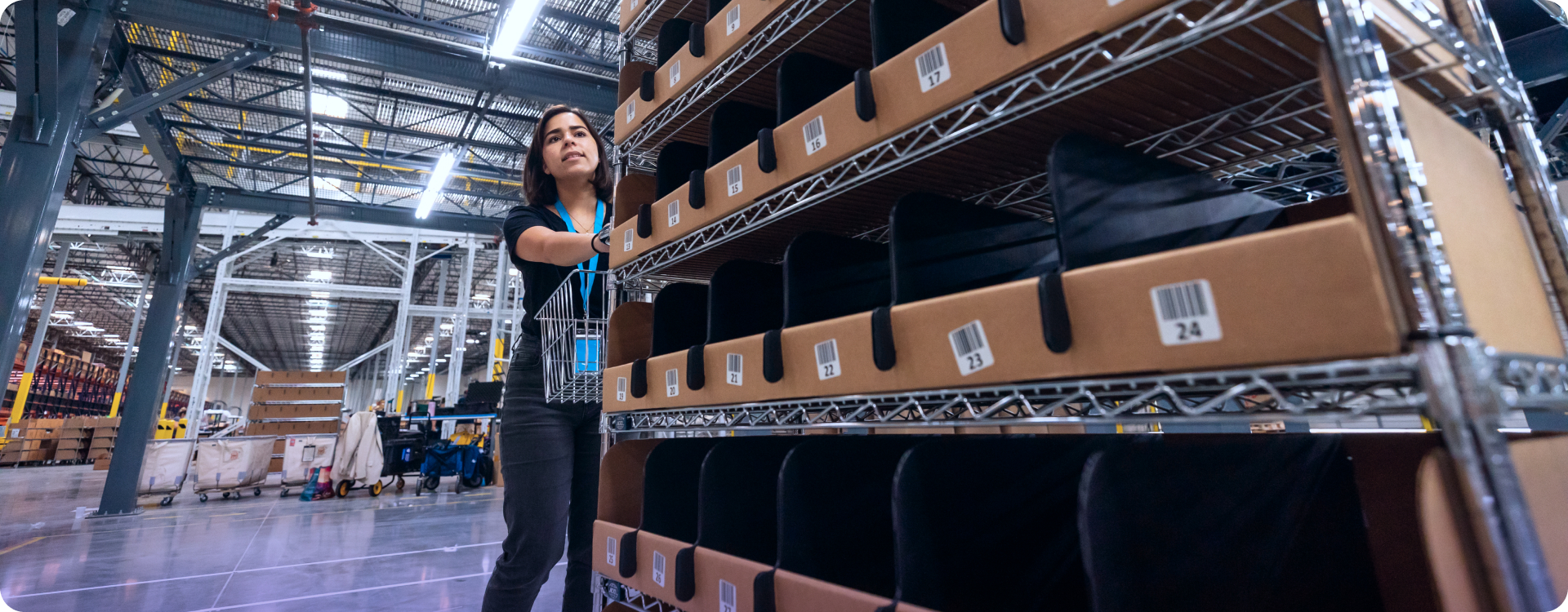Order Picking Methods: Finding the Right Strategy for You
Order picking is widely reported to account for 50% to 55% of total warehouse operational costs. Identifying the right picking strategy can have a significant impact on the bottom line.

Why is choosing an order picking strategy so important?
An integral process in warehouse operation management, the speed and accuracy of the order picking process is essential to achieving seamless workflow and higher level business objectives including productivity, customer satisfaction, and ultimately profitability. Uncertain labor and increasing warehouse operation costs prioritize effective resource management of people and processes. Inefficient order picking processes waste valuable time and resources, working against warehouse leaders’ strategies and making operational goals unattainable or expensive to achieve.
Warehouse picking is widely reported to account for 50% to 55% of total warehouse operational costs. Consequently, identifying the right picking strategy can have a significant impact on the bottom line, with the potential to increase both warehouse productivity and profitability. Key performance indicators (KPIs) such as throughput, order accuracy, and order cycle time should be set and tracked, making adjustments as needed.
Goals of an effective warehouse picking process:
- Reduce cycle time
- Minimize bottlenecks
- Increased and sustained order accuracy
- Minimal inventory damage/loss
- Higher customer order satisfaction
- Maximize human productivity safely
- Minimize non-value-added activities
Businesses can use a variety of order picking methods and types to create the best strategy to support an efficient, profitable operation. Certain methods may be more efficient than others depending on a number of warehouse operations factors:
- Size of facility, aisle, and bins
- Product type and quantity of SKUs
- Order volume and picking method
- Order to Ship Service Level Agreements (SLAs)
- Order Profile and Volume
Warehouse order picking strategies should be customized to fit your business’s unique fulfillment needs and goals with aims to increase throughput and reduce cycle time and costs. Evaluating the advantages and disadvantages of various picking methods and supporting technologies can help to determine the right method or combination of methods that provide the greatest benefit to your business.
Order Picking Methods
01 — Zone Picking
Zone picking, or pick and pass picking, organizes the warehouse into several discrete zones, with dedicated order pickers assigned to work within a specific zone and only picking SKUs within that zone. Multiple zones, which may include both storage and picking zones, are created on the warehouse floor. Orders may pass through several zones for completion and consolidated for shipping if multiple SKUs throughout the warehouse are required.
PROS
- Can reduce travel time for individual pickers
- Beneficial for high volume warehouses
- Workers’ familiarity with SKUs in their zone can support accuracy
- Improves efficiency in the picking process by optimizing picking routes and aisle travel
CONS
- Difficult to manage an efficient distribution of labor: One zone may have low volume with unproductive workers while others can’t keep up and the only resolution is manual supervisor intervention
- SKUs must be accurately tracked, as orders may pass through multiple zones to be completed
- Larger effort required for order release planning with multiple order cutoff times
- Potential risk to order cycle time as zones are dependent on the pace of other zones to complete work
- Can create bottlenecks in multi order picking or when consolidating customer orders across bins and racks
02 — Discrete Picking
Also known as single order picking, discrete order picking is the most common and oldest picking method used in warehouses. Typically referring to a printed pick list, one worker compiles each piece of necessary inventory in the order, one line at a time. Once the order is complete it is packed and sent for shipping.
PROS
- Simple approach with minimal strategy and employee training time
- Works well in smaller warehouses with low volume and less complex orders
- Minimizes number of touches and potential for errors
CONS
- Can be inefficient as orders and routes are not optimized
- Time consuming compared to other picking methods
- Requires worker to make a full trip through warehouse for each order, reducing efficiency
03 — Batch Picking
Batch picking, or multi-order picking, enables workers to pick multiple SKUs from multiple orders at the same time. The orders are grouped into small batches and the worker is given a pick list that includes items in a batch and picks one SKU at a time for a batch of multiple orders. Batch picking works best for companies with orders that have a small number of SKUs.
PROS
- Can improve speed of workflow with pickers picking multiple orders at a time
- Eliminates unnecessary trips and reduces travel time for worker
- Reduces worker congestion by grouping picks for smaller amount of workers
CONS
- Increases chance of errors with multiple orders
- May require additional technology to identify best batches and routes for pickers
04 — Wave Picking
Wave picking allocates workers to a specific inventory or storage zone where picking is done at specific times during the day. Wave picking organizes and groups orders by common criteria, such as similar SKUs in similar zones in the warehouse and similar shipping deadlines. Orders are picked in a batch and released at certain times throughout the day in waves that align with shipping activity and timelines, so warehouse managers can better schedule resources aligned with shipping deadlines or shift productivity goals. Wave picking can be performed similar to discrete order picking or like batch picking, and works best for warehouses with a larger amount of SKUs and variable product sizes.
PROS
- Increases worker productivity and reduces idle picker time
- Enables warehouse managers to better coordinate and allocate resources for end-to-end operations including receiving, picking and shipping
CONS
- Higher number of workers are necessary for sorting and consolidation of orders
- Difficult to process last-minute or high-priority orders
- Dependent on warehouse management system (WMS) analysis to properly allocate orders and resources or a high level of effort of manual management to monitor and analyze the right timing decisions
05 — Cluster Picking
In cluster picking the picker will simultaneously pick various SKUs to complete multiple orders, working with a cart that is loaded with a different tote or shipping container per order. Cluster picking works best for small or medium sized product as multiple orders are handled on one cart.
PROS
- Reduces travel as worker only needs to go to an area of the warehouse once for the required SKUs
- Orders can be quickly shipped if picked directly to shipping container
CONS
- Increases number of manual touches during pack-out/sortation.
- All multi-line orders require sortation at the packout area, which may include high levels of putwall equipment or other sortation automation
- Does not significantly reduce worker travel time since worker may go to multiple warehouse areas or zones to complete orders
- Number of orders can be limited by size of cart
Common Warehouse Picking Questions
Q: What are the most common order picking methods in warehouses?
A: Common warehouse picking methods include single order picking, batch picking, zone picking, wave picking, and cluster picking. Choosing the right picking method depends on factors like order volume, warehouse size, picking routes, and the type of goods handled to optimize your order picking process and reduce bottlenecks.
Q: How do warehouse managers improve efficiency in the order picking process?
A: Warehouse managers can streamline the picking process by optimizing picking routes, consolidating bins and containers, and using a warehouse management system (WMS). Implementing the right picking method for your warehouse can reduce travel time, improve order accuracy, and lower warehouse operating costs.
Q: How do I choose the right picking method for a large warehouse?
A: In a large warehouse, methods like zone picking or wave picking can improve efficiency by optimizing picking routes and minimizing travel between aisles and racks. Pairing the right method with a warehouse management system ensures smoother order picking, reduces bottlenecks, and helps manage high order volume.
Q: Which order picking method works best for high order volume?
A: For high order volume, batch picking or cluster picking is often most effective. These methods allow workers to pick multiple customer orders at once, consolidate items into bins or containers, and streamline the packing and shipment process while reducing travel and labor costs.
Technology to Support Order-Picking Productivity
Optimizing order picking can have a significant impact on customer experience and profitability. An individual or a combination of order picking methods can be tailored and implemented in manual operations to streamline fulfillment. The efficiency and accuracy of these order picking methods can be enhanced with technology such as automated mobile robots (AMRs) that can work alongside people and across zones to boost productivity and worker satisfaction.
Onward Robotics’ powerful new person-to-goods solution combines proprietary software with mobile robots to dramatically increase operational efficiency and eliminate downtime in warehousing, distribution, and fulfillment centers. See how Onward Robotics is lighting and leading the way in a new era of order fulfillment.


